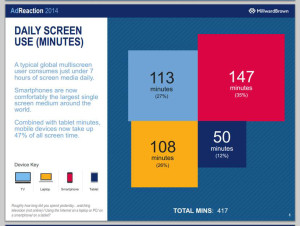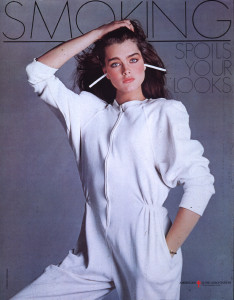 In 2014, we are digital omnivores. Most people “consume” information and entertainment on more than one screen: 7 hours’ worth over a 5-hour period.
In 2014, we are digital omnivores. Most people “consume” information and entertainment on more than one screen: 7 hours’ worth over a 5-hour period.
You read that right: most people who watch TV, use a laptop or PC, smartphone or tablet are multitasking use of these devices in parallel.
And above all, people are using smartphones as their primary screen.
The AdReaction: Marketing in a multiscreen world report from Millward Brown paints a picture of global consumers who are cobbling together multiscreen experiences. The smartphone has become the “do it all” device if you don’t carry a laptop or tablet around, especially favored for social check-ins and messaging. Laptops are productivity tools, best for online shopping and watching TV. Tablets are considered great for “content in transit,” a next-best entertainment alternative beginning to extend the TV experience.
The key finding: 65% of media use is shifting from one screen to another. The typical shifts are TV to smartphone, TV to laptop, and smartphone to laptop.
Thus, Millward Brown recommends that marketers be consistent in content and messaging across all media, be connected when it comes to seamless multiscreen experiences, be considered depending on what’s communicated on a particular screen and brand message, and be concise — especially with mobile-friendly, shareable content that “entertains first, informs second.”
Millward Brown has identified six multiscreen personae:
- Passivists, the largest group comprising 42% of people: this plurality uses screen media the least. They tend to be over 35, more male, and unlikely to watch TV and use multiple devices.
- Phonistas, 19% of people: 1 in 5 people use smartphones more than other media, and skew younger and more female. They are very social.
- Laptoperati, 15%: this group has the highest use of laptop computers and is more male.
- Couch chatters, 10%: with greater use of TV and smartphones, this group is more female and multitasking socially and via mobile.
- Digital dynamos, 8%: these digeratis likely combine use of laptop, smartphone and tablet, both female and male.
- Mega multiscreeners, 6%: this smallest segment has the highest use of all media, is older and more active in engaging with media following up TV.
See Millward Brown’s summary video on marketing in a multiscreen world here.
Health Populi’s Hot Points: This study is particularly intriguing when thinking about marketing health, health care products and services, and public health messages.
Consider the marketing of The Affordable Care Act, Obamacare, and the health insurance exchanges Healthcare.gov. As #POTUS and his health care legacy approaches the deadline for health insurance enrollment on March 31, 2014, a big marketing push has ensued across different screens. In particular, the effort’s outreach to younger people who are a major target for sign-ups is crossing communications platforms with entertaining formats and messages:
- Between Two Ferns on Funny or Die, starring Zack Galifianakis and President Obama, in a talk-show format that’s got fun value in it and quickly went viral (which led to a 40% increase in traffic to the Healthcare.gov website)
- The White House’s 16 reasons to get covered, with Healthcare.gov teaming with 2014 NCAA March Madness basketball fever, featuring a campaign with LeBron James
- President Obama talking more seriously with WebMD.
It takes a village when it comes to communications for health, as this example points out.
 Once upon a time, an outdoor billboard and print magazine ads (still useful communications channels) featuring Brooke Shields in an anti-smoking campaign worked well for campaigning against tobacco for kids and teens.
Once upon a time, an outdoor billboard and print magazine ads (still useful communications channels) featuring Brooke Shields in an anti-smoking campaign worked well for campaigning against tobacco for kids and teens.
Beyond messaging, these multiple platforms also become health care channels for people managing chronic conditions and trying to making behavior changes for the better. Note that AbilTo, a technology-based program focused on mental and physical health, garnered $6 mm of investment from Sandbox Industries (Blue Cross Blue Shield Venture Partners) earlier this week. And telehealth is gaining traction with payors and providers alike, with more health consumers keen to access care outside of the doctor’s office for greater convenience.
Today, multiple channels are required to bolster health messaging and meet people in their media-shifting lives. Health stakeholders will need to meet patients, people and caregivers where they want to be met for health, keeping in mind the art of consumer segmentation.
Postscript 3/19 at 3 pm: Choosing to add the traditional TV platform to his media-armaments for marketing Healthcare.Gov, USA Today published a story talking about President Obama planning to appear on the talk show Ellen to promote health insurance here.




 Thank you, Jared Johnson, for including me on the list of the
Thank you, Jared Johnson, for including me on the list of the  I am so grateful to Tom Lawry for asking me to pen the foreword for his book, Health Care Nation,
I am so grateful to Tom Lawry for asking me to pen the foreword for his book, Health Care Nation,  Thanks to Feedspot for naming this blog, Health Populi, as a
Thanks to Feedspot for naming this blog, Health Populi, as a